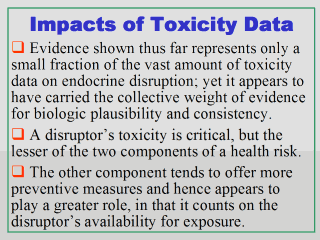The evidence
presented in the last three slides represents only a very small fraction of
the enormous amount of toxicity data on endocrine disruption. Neither are
the few studies all that representative of the most relevant collection of
the work done on the subject today. Yet the literature data provided here
appear to have carried the collective weight of evidence for biologic
plausibility and consistency, which are the two most crucial criteria for
establishing a causal relationship. These limited data thus collectively are
still considered as providing sufficient evidence for the concern that
certain environmental endocrine disruptors (EEDs) can be toxic and potent,
and that their disruption effects in humans and wildlife can be severe.In
closing this first chapter (part), it is important to note that from a
public health standpoint, a disruptorís toxicity or potency is the lesser
important of the two key components of a health risk. The other key
component tends to offer more preventive measures and hence appears to play
a greater role, in that it counts on the disruptorís availability for
exposure. A chemicalís availability, especially that of an EED, is measured
by its usage, its persistence, and the potential for its bioaccumulation by
organisms in an ecosystem. Though often not considered as the most
desirable, an effective or complete prevention or mitigation measure is of
course to ban the chemical in question.
Whether or not a chemicalís production and use should be banned or
substantially reduced depends primarily on its toxicity, persistence, and
bioaccumulation properties. Part I here has just presented the general
toxicity of EEDs. Their bioaccumulation and persistence properties are the
topics of extensive discussion given in
